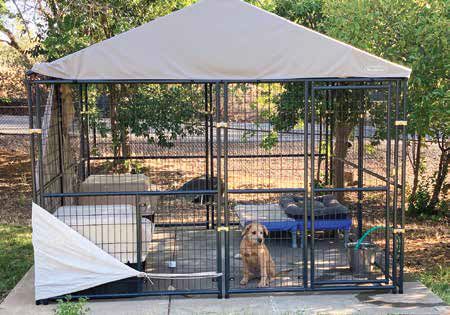
Maybe your home lacks a fenced-in yard. Or maybe it doesn’t, but you want to protect its lush landscaping. Or maybe your dog needs a quiet place to rest while you entertain al fresco. Or you need a safe spot for your dog while you run an errand and he’s not ready to be loose in the house – but you want him to have more space than contained in a crate.
When used responsibly, an outdoor dog kennel can be used similar to a crate – as a safe space for a dog to relax when you’re not able to appropriately supervise her. Modern outdoor dog kennels (also known as “outdoor dog runs”) come in a variety of customizable sizes, materials, and designs to complement any taste or need.
When might you use an outdoor dog kennel? There are several situations where a kennel can be beneficial:
- To safely give dogs some outdoor time when a fenced yard is not available. (In this case, “safe” means your home is safe from any destructive canine activities and your dog is safe from any potential animal intruders.)
- When you’re unable to directly supervise a dog in outdoor situations where lack of supervision might lead to unwanted outcomes (such as fence-fighting, digging up the landscaping, chasing the family cat, etc.).
- To contain escape-artist dogs left outside when you’re not home. To help teach dogs to not just calmly accept but also enjoy time away from their owners.
CHOOSING AN OUTSIDE DOG KENNEL
Pre-fabricated kennels come in a variety of shapes and sizes, and custom kennels, as the name suggests, can be designed to accommodate almost any needs or wants. Most are designed and sold in a modular form, with a minimum of panels that are clamped together to form a small-sized enclosure, with additional panels (sold separately) that can be added to make the enclosure larger.
Because an outdoor kennel should only be used as temporary accommodation, it need not provide a vast abundance of space. Consider the size of the dog and the number of dogs to be contained within the outdoor dog kennel, and make sure the enclosure is large enough to allow space for relieving away from where your dog is likely to rest.
Square enclosures measuring 10 feet by 10 feet work well for even large-breed dogs. If containing more than one medium- to large-breed dog, consider an enclosure that’s at least twice as long as it is wide. If your environment and budget can support a larger enclosure, that’s great.
Carefully consider your dog’s temperament and athletic ability and make sure the panels are tall enough to prevent an escape. Or, better yet, look for an enclosure that can accommodate a top panel or cover, especially if you have one of those talented, determined climbers.
CREATING A SAFE AND COMFORTABLE KENNEL ENVIRONMENT
Consider these key points when installing an outdoor dog kennel:
- Location, location, location. Choose an area of the yard free from distractions that might frustrate your dog. If your dog is prone to running along your shared fence line when neighbor dogs are present, avoid installing the dog kennel in that area. If watching the family enjoying the pool whips your dog into a frenzy, aim to locate the dog kennel out of view of the pool. Ideally, your dog will be relaxed – not just contained – when in the outdoor kennel.
- Protection from elements. Avoid installing the outdoor dog kennel in areas where there is no shade, or where your dog would be exposed to a relentless wind.
- Install within reach of a water source. It’s important to keep your dog’s outdoor kennel clean, and you’ll want easy access to a hose.
When it comes to designing your outdoor dog kennel flooring, there are several options to choose from:
- Utilize the existing ground covering. The existing dirt or grass in your yard may be sufficient. However, if your dog is a digger – who may experiment with digging out of the enclosure – you’ll need to dig-proof the perimeter of the kennel. This can often be accomplished by lining the perimeter with cinderblocks or pavers, large rocks, or by attaching a strip of wire or plastic snow fencing to the bottom of the enclosure and burying the fencing underground.
- Decomposed granite or pea gravel. This is often recommended over gravel, stone, or sand as it’s softer on the pads and doesn’t hold as much heat in hot weather.
- Concrete. Concrete is a fan favorite among kennel professionals for its ease of cleaning and sanitization. If installing a concrete slab, consider pouring the concrete on a slight slope to promote proper drainage.
- Artificial turf. Many dog owners like artificial turf because, unlike living grass, it doesn’t die and become discolored from urine. However, in warm climates, unless it’s completely shaded, artificial turf can become hot to the touch, and it can require extra care to prevent and manage odors in areas of frequent elimination.
ACCESSORIZE FOR MAXIMUM COMFORT
It’s important to outfit your outdoor dog kennel with the proper accessories to keep your dog safe and comfortable:
- Access to plenty of fresh water. Always have plenty of water available. If your dog is likely to spill a bowl of water, consider hanging a large stainless steel water bucket. If a water spigot is accessible, consider installing a dog faucet device like the Lixit for easy access to constantly fresh water. (Note: Until you know your dog is proficient at using the Lixit, be sure to provide a secondary water source that’s more familiar – such as a large bowl or bucket.)
- Elevated resting area. An elevated cot or padded platform helps keep your dog cool in warm weather by allowing air to circulate below him. It can also keep him clean and help prevent elbow callouses that sometimes form similar to pressure sores. Such sores are more common on larger and older dogs who spend more time lounging on hard surfaces such as tile floors or concrete spaces.
- Appropriate shade and shelter. Use well-placed, breathable shade fabric to help keep the area cool and protect your dog from excessive exposure to the sun’s ultraviolet rays. Be sure to use breathable materials that allow sufficient airflow. Consider adding a doghouse as an even quieter spot to catch a nap or as protection from unexpected inclement weather.
- Enrichment activities. Outfit your dog’s outdoor kennel with fun and interesting things to do. A child’s wading pool can be the source of cooling water fun or filled with sand to create a digging pit. If your dog likes to tug, a rope toy can be affixed to a post along the kennel frame. Make plenty of toys and raw, meaty bones or food-stuffed toys available to your dog. For a real challenge, hang a food-stuffed toy (such as a Kong or Toppl) from the top of the dog kennel and encourage your dog to work the puzzle as it dangles.
TEACH YOUR DOG TO ENJOY KENNEL TIME
Teaching your dog to accept and enjoy time in an outdoor dog kennel is similar to teaching your dog to enjoy time in a crate. (See “Crate Training to Keep Your Dog Content,” WDJ October 2021.) Feeding meals and/or giving him chews and treat-stuffed toys in the outdoor kennel can quickly establish a positive association with being in the outdoor run – especially if that’s the only place he receives those special treats. You can also accompany your dog inside the kennel for some fun play. Make initial training sessions short and fun.
Just as with crates, don’t use time in the kennel as a “time out” location or punishment. It’s important to preserve your dog’s positive association with short-term confinement. And most importantly, be sure not to overuse the outdoor kennel. Dogs are family, and they deserve to spend as much of their relatively short lives as possible in the company of their beloved humans.





